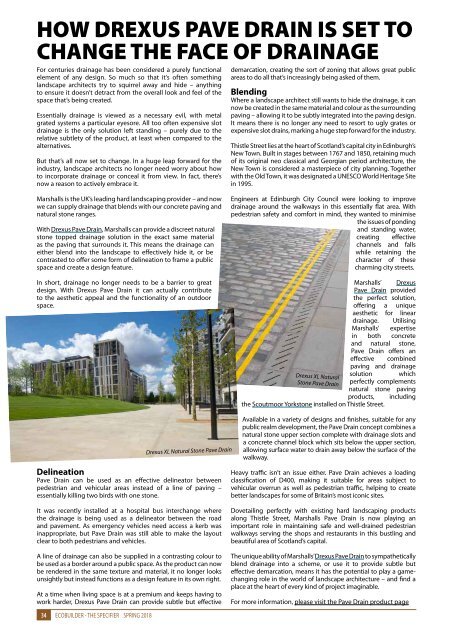ECOBuilder-Specifiers Journal spring2018
Create successful ePaper yourself
Turn your PDF publications into a flip-book with our unique Google optimized e-Paper software.
HOW DREXUS PAVE DRAIN IS SET TO<br />
CHANGE THE FACE OF DRAINAGE<br />
For centuries drainage has been considered a purely functional<br />
element of any design. So much so that it’s often something<br />
landscape architects try to squirrel away and hide – anything<br />
to ensure it doesn’t detract from the overall look and feel of the<br />
space that’s being created.<br />
Essentially drainage is viewed as a necessary evil, with metal<br />
grated systems a particular eyesore. All too often expensive slot<br />
drainage is the only solution left standing – purely due to the<br />
relative subtlety of the product, at least when compared to the<br />
alternatives.<br />
But that’s all now set to change. In a huge leap forward for the<br />
industry, landscape architects no longer need worry about how<br />
to incorporate drainage or conceal it from view. In fact, there’s<br />
now a reason to actively embrace it.<br />
demarcation, creating the sort of zoning that allows great public<br />
areas to do all that’s increasingly being asked of them.<br />
Blending<br />
Where a landscape architect still wants to hide the drainage, it can<br />
now be created in the same material and colour as the surrounding<br />
paving – allowing it to be subtly integrated into the paving design.<br />
It means there is no longer any need to resort to ugly grates or<br />
expensive slot drains, marking a huge step forward for the industry.<br />
Thistle Street lies at the heart of Scotland’s capital city in Edinburgh’s<br />
New Town. Built in stages between 1767 and 1850, retaining much<br />
of its original neo classical and Georgian period architecture, the<br />
New Town is considered a masterpiece of city planning. Together<br />
with the Old Town, it was designated a UNESCO World Heritage Site<br />
in 1995.<br />
Marshalls is the UK’s leading hard landscaping provider – and now<br />
we can supply drainage that blends with our concrete paving and<br />
natural stone ranges.<br />
With Drexus Pave Drain, Marshalls can provide a discreet natural<br />
stone topped drainage solution in the exact same material<br />
as the paving that surrounds it. This means the drainage can<br />
either blend into the landscape to effectively hide it, or be<br />
contrasted to offer some form of delineation to frame a public<br />
space and create a design feature.<br />
In short, drainage no longer needs to be a barrier to great<br />
design. With Drexus Pave Drain it can actually contribute<br />
to the aesthetic appeal and the functionality of an outdoor<br />
space.<br />
Engineers at Edinburgh City Council were looking to improve<br />
drainage around the walkways in this essentially flat area. With<br />
pedestrian safety and comfort in mind, they wanted to minimise<br />
the issues of ponding<br />
and standing water,<br />
creating effective<br />
channels and falls<br />
while retaining the<br />
character of these<br />
charming city streets.<br />
Marshalls’ Drexus<br />
Pave Drain provided<br />
the perfect solution,<br />
offering a unique<br />
aesthetic for linear<br />
drainage. Utilising<br />
Marshalls’ expertise<br />
in both concrete<br />
and natural stone,<br />
Pave Drain offers an<br />
effective combined<br />
paving and drainage<br />
solution which<br />
perfectly complements<br />
natural stone paving<br />
products, including<br />
the Scoutmoor Yorkstone installed on Thistle Street.<br />
Drexus XL Natural<br />
Stone Pave Drain<br />
Drexus XL Natural Stone Pave Drain<br />
Delineation<br />
Pave Drain can be used as an effective delineator between<br />
pedestrian and vehicular areas instead of a line of paving –<br />
essentially killing two birds with one stone.<br />
Available in a variety of designs and finishes, suitable for any<br />
public realm development, the Pave Drain concept combines a<br />
natural stone upper section complete with drainage slots and<br />
a concrete channel block which sits below the upper section,<br />
allowing surface water to drain away below the surface of the<br />
walkway.<br />
Heavy traffic isn’t an issue either. Pave Drain achieves a loading<br />
classification of D400, making it suitable for areas subject to<br />
vehicular overrun as well as pedestrian traffic, helping to create<br />
better landscapes for some of Britain’s most iconic sites.<br />
It was recently installed at a hospital bus interchange where<br />
the drainage is being used as a delineator between the road<br />
and pavement. As emergency vehicles need access a kerb was<br />
inappropriate, but Pave Drain was still able to make the layout<br />
clear to both pedestrians and vehicles.<br />
A line of drainage can also be supplied in a contrasting colour to<br />
be used as a border around a public space. As the product can now<br />
be rendered in the same texture and material, it no longer looks<br />
unsightly but instead functions as a design feature in its own right.<br />
At a time when living space is at a premium and keeps having to<br />
work harder, Drexus Pave Drain can provide subtle but effective<br />
Dovetailing perfectly with existing hard landscaping products<br />
along Thistle Street, Marshalls Pave Drain is now playing an<br />
important role in maintaining safe and well-drained pedestrian<br />
walkways serving the shops and restaurants in this bustling and<br />
beautiful area of Scotland’s capital.<br />
The unique ability of Marshalls’ Drexus Pave Drain to sympathetically<br />
blend drainage into a scheme, or use it to provide subtle but<br />
effective demarcation, means it has the potential to play a gamechanging<br />
role in the world of landscape architecture – and find a<br />
place at the heart of every kind of project imaginable.<br />
For more information, please visit the Pave Drain product page<br />
34 ECOBUILDER - THE SPECIFIER SPRING 2018







